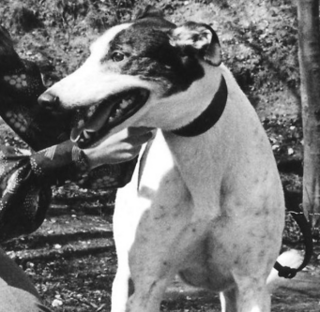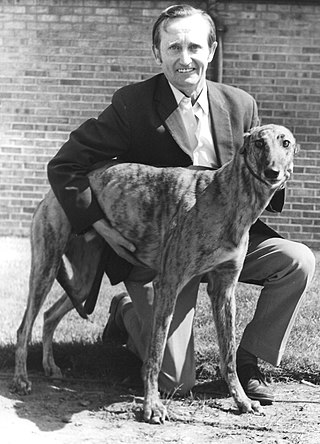| 1941 UK & Ireland Greyhound Racing Year | |
|---|---|
 Ballynennan Moon, the leading greyhound during the war | |
The 1941 UK & Ireland Greyhound Racing Year was the 16th year of greyhound racing in the United Kingdom and Ireland. [1]
| 1941 UK & Ireland Greyhound Racing Year | |
|---|---|
 Ballynennan Moon, the leading greyhound during the war | |
The 1941 UK & Ireland Greyhound Racing Year was the 16th year of greyhound racing in the United Kingdom and Ireland. [1]
The year was dominated by the effects of World War II. The remaining classic races that had not been suspended in 1940 were duly suspended in 1941, with the exception of the Irish Greyhound Derby and Scottish Greyhound Derby. [2] [3] [4]
Racing did continue at many venues but was restricted to afternoons during the winter, this is because of the blackout regulations and during the summer the meetings were held in the early part of the evening. Matinee meetings would also take place on weekends at some tracks. Staffing the racing worsened as many of the stadium and kennel staff were called up to serve. [2] [3] [4]
Remarkably, despite restrictions on racing then annual totalisator turnover set a new record, reaching £42,027,642 and with a tax of 6% was a significant income for the government. [5]
on 22 September, leading trainer Joe Harmon died, leaving a huge gap to fill in the trainers ranks. [6]
Shortly before his death, trainer Joe Harmon continued his successful run of big race wins by training Lights O'London, who won the Scottish Derby. [7] Ballycurreen Soldier reached his third consecutive Scottish Derby final under the training of a third different trainer. The event was completed in one evening, with heats at 7:35 pm and 7:55 pm and the final later at 9:45 pm. [8] [9] The principal London races remaining on the open race calendar were The Cambridgeshire, Wimbledon Spring Cup, Wimbledon Gold Cup, Wembley Gold Cup and Two Year Old Produce Stakes, also at Wimbledon. [2] [3] [4]
Ballynennan Moon, now with Sidney Orton and owned by mrs Cearns, won the Wembley Summer Cup in August, [10] quickly followed by the Berkeley Cup and was beginning to come to prominence as the nation's leading greyhound. However, with no English Greyhound Derby taking place, this brindle dog would never have the opportunity to claim the sport's biggest prize. [11]
Iris racing suffered from the dreaded Foot-and-mouth disease; traveling almost ceased and the Irish tracks came to a standstill in many areas. The ban was finally lifted at the end of the summer and hectic plans were drawn up to save the Irish Derby before the year ended. This resulted in a late October slot for the competition and would be run at Shelbourne Park because Cork Greyhound Stadium had ruled themselves out from being able to stage the race. Harold's Cross Stadium also managed to stage the Grand National at late notice, which went down well with the Irish Coursing Club, who had noted that both Dublin tracks had come to the rescue. The Grand National title went to The Gunner. [2] [3] [4] [12] The Irish Greyhound Derby winner Brave Damsel, owned by John Byrne and The Gunner, were both sold to England. The latter was bought by a syndicate in Oxford for the sum of £400 and would become a crowd favourite at the recently built Oxford Stadium because of his hurdling ability. [13]
| Major Winners | |
|---|---|
| Award | Name of Winner |
| 1941 English Greyhound Derby | Suspended |
| 1941 Irish Greyhound Derby [13] | Brave Damsel |
| 1941 Scottish Greyhound Derby [14] | Lights O'London |
| 1941 Welsh Greyhound Derby | Suspended |
| |||||||||||||||||||||||||||||||||||||||||||||||||
| Date | Stadium/Track | Location | Ref |
|---|---|---|---|
| 22 March | Doncaster Greyhound Stadium | Doncaster | [15] |

Wimbledon Stadium, also known as Wimbledon Greyhound Stadium, was a greyhound racing track located in Wimbledon in southwest London, England.

Wembley Greyhounds was the greyhound racing operation held at Wembley Stadium in London.
The 1928 UK & Ireland Greyhound Racing Year was the third year of greyhound racing in the United Kingdom and Ireland.
The 1929 UK & Ireland Greyhound Racing Year was the fourth year of greyhound racing in the United Kingdom and Ireland.

The 1930 UK & Ireland Greyhound Racing Year was the fifth year of greyhound racing in the United Kingdom and Ireland.

Ballynennan Moon was a famous racing greyhound during World War II. He is regarded as being one of the greatest racing greyhounds and was denied the opportunity to win the English Greyhound Derby because of the postponement of the event during the war years.
The 1936 UK & Ireland Greyhound Racing Year was the 11th year of greyhound racing in the United Kingdom and Ireland.
The 1938 UK & Ireland Greyhound Racing Year was the 13th year of greyhound racing in the United Kingdom and Ireland.
The 1939 UK & Ireland Greyhound Racing Year was the 14th year of greyhound racing in the United Kingdom and Ireland.
The 1940 UK & Ireland Greyhound Racing Year was the 15th year of greyhound racing in the United Kingdom and Ireland.
The 1942 UK & Ireland Greyhound Racing Year was the 17th year of greyhound racing in the United Kingdom and Ireland.
The 1943 UK & Ireland Greyhound Racing Year was the 18th year of greyhound racing in the United Kingdom and Ireland.
The 1944 UK & Ireland Greyhound Racing Year was the 19th year of greyhound racing in the United Kingdom and Ireland.

The 1953 UK & Ireland Greyhound Racing Year was the 28th year of greyhound racing in the United Kingdom and Ireland.
The 1964 UK & Ireland Greyhound Racing Year was the 38th year of greyhound racing in the United Kingdom and Ireland.
The 1965 UK & Ireland Greyhound Racing Year was the 39th year of greyhound racing in the United Kingdom and Ireland.

The 1970 UK & Ireland Greyhound Racing Year was the 44th year of greyhound racing in the United Kingdom and Ireland.

The 1971 UK & Ireland Greyhound Racing Year was the 45th year of greyhound racing in the United Kingdom and Ireland.

The 1972 UK & Ireland Greyhound Racing Year was the 46th year of greyhound racing in the United Kingdom and Ireland.
The 1984 UK & Ireland Greyhound Racing Year was the 58th year of greyhound racing in the United Kingdom and Ireland.